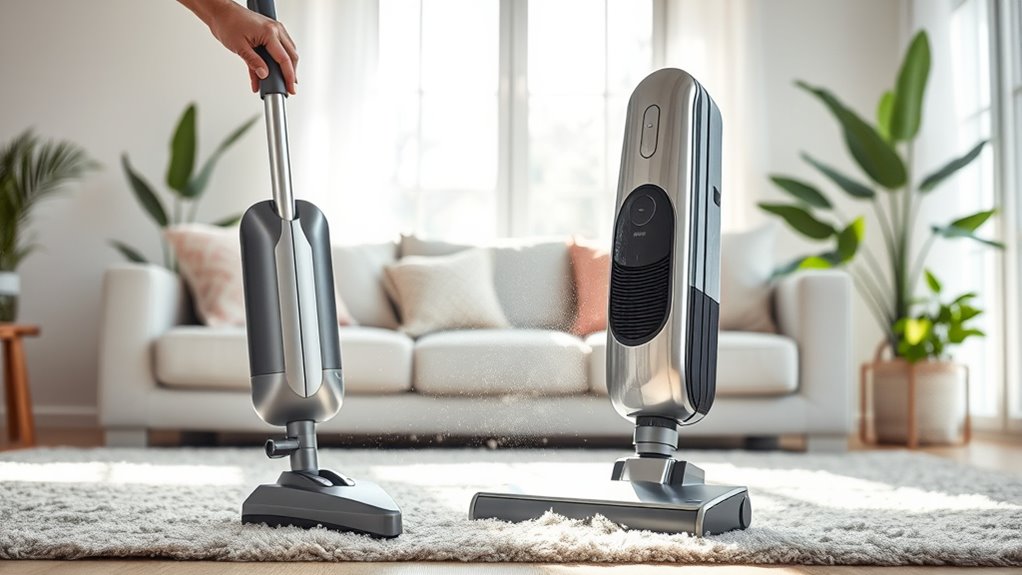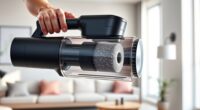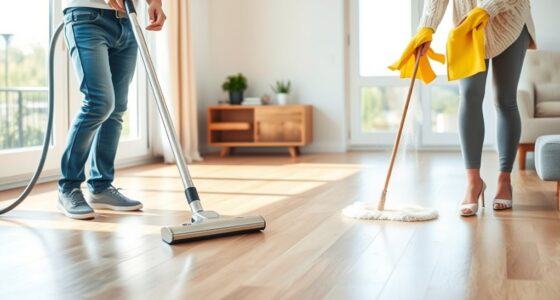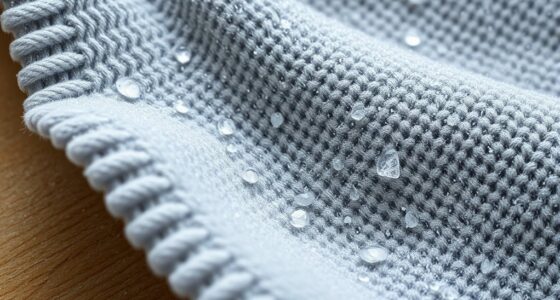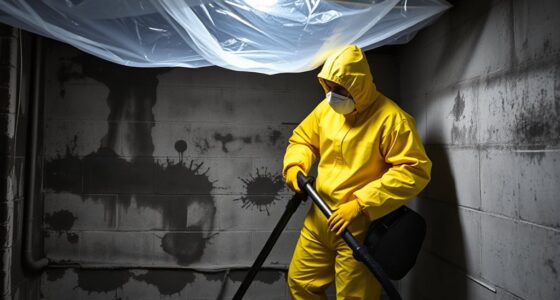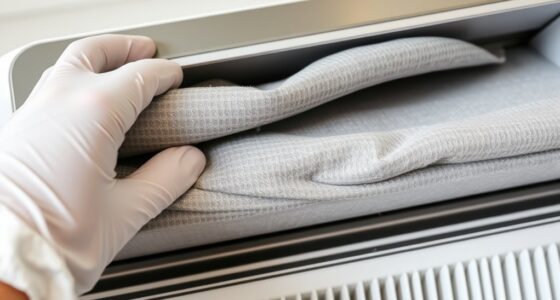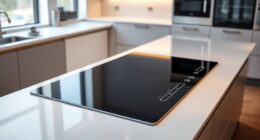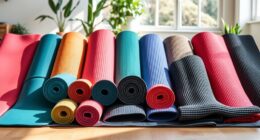To beat seasonal allergies, vacuum at least twice a week with a HEPA filter-equipped cleaner. Focus on carpets, rugs, upholstery, and tight spaces like baseboards. Wear a mask if needed and open windows to ventilate. Use allergy-proof bedding and wash it weekly in hot water. Combining these strategies with air purifiers boosts your indoor air quality. Keep exploring to discover more effective tips for allergy relief and cleaner living.
Key Takeaways
- Use a HEPA-filter vacuum to effectively trap tiny airborne allergens like pollen and dust mites.
- Vacuum carpets, rugs, and upholstery at least twice weekly, especially during allergy seasons.
- Pay attention to baseboards, corners, and under furniture where allergens tend to accumulate.
- Wear a mask and ventilate rooms during vacuuming to minimize allergen inhalation.
- Combine regular vacuuming with air purifiers for comprehensive indoor allergen control.
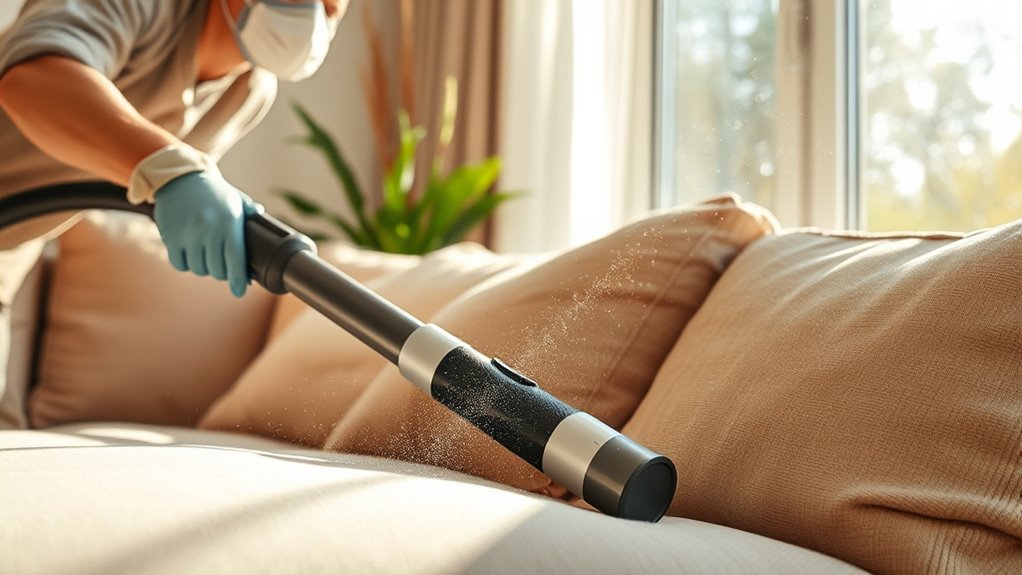
As seasonal allergies peak, regular vacuuming becomes essential for reducing airborne allergens and keeping your home comfortable. When you vacuum frequently and effectively, you help remove dust mites, pollen, pet dander, and other irritants that can trigger allergy symptoms. Using an air purifier benefits your efforts by capturing airborne particles that vacuuming alone might miss, creating a cleaner indoor environment. Air purifiers with HEPA filters are especially good at trapping tiny allergens, so running one in common areas can considerably improve your indoor air quality.
Regular vacuuming and HEPA air purifiers effectively reduce airborne allergens indoors.
In addition to vacuuming, paying attention to your bedding can make a big difference. Allergy-proof bedding is designed to create a barrier against dust mites and other allergens that settle in pillows, mattresses, and comforters. Encase these items in allergen-proof covers, which prevent allergens from penetrating the fabric and help you breathe easier while you sleep. Washing your bedding weekly in hot water also substantially reduces allergen buildup, ensuring you’re not sleeping surrounded by accumulated dust and dander.
To maximize your vacuuming strategy, choose a vacuum cleaner equipped with a high-efficiency particulate air (HEPA) filter. These filters trap tiny particles, preventing them from escaping back into the air as you clean. Make sure to vacuum carpets, rugs, and upholstery thoroughly, paying special attention to areas where dust and pet hair tend to accumulate. Don’t forget to vacuum along baseboards, under furniture, and in tight corners — places where allergens tend to settle. Regularly replacing or cleaning the vacuum filter ensures it continues to perform at its best.
For hard floors, use a vacuum with strong suction and consider a microfiber or electrostatic mop afterward to pick up any remaining allergens. Be cautious with your cleaning routine: wear a mask if needed, and open windows when possible to ventilate and disperse airborne particles. Consistency is key; vacuum at least twice a week during peak allergy season, and increase frequency if you have pets or live in a dusty environment.
Frequently Asked Questions
Can Vacuuming Alone Eliminate All Allergy Symptoms?
Vacuuming alone can’t eliminate all allergy symptoms, but it helps reduce allergens like dust and pollen. To improve relief, consider using air purifiers alongside regular vacuuming. These devices trap airborne particles your vacuum misses. Also, continue allergy medications as recommended by your doctor for thorough relief. Combining these strategies creates a more effective approach, so you’re less likely to suffer from seasonal allergy symptoms.
How Often Should I Vacuum During Peak Allergy Season?
Did you know that vacuuming twice a week during peak allergy season can substantially reduce airborne allergens? You should vacuum at least every 2-3 days to keep pollen and dust mites at bay. Combine this with air purifier benefits and allergen-proof bedding for better relief. Regular vacuuming helps maintain a cleaner environment, making allergy symptoms more manageable and your home’s air healthier to breathe.
Are There Specific Vacuum Features Best for Allergy Sufferers?
You should look for vacuums with HEPA filters and adjustable suction for allergy relief. HEPA filters trap tiny allergens like dust mites and pollen, preventing them from recirculating into the air. Adjustable suction helps you customize cleaning power for different surfaces without stirring up allergens. These features make your vacuum more effective at reducing allergens, helping you breathe easier during peak allergy season.
Should I Vacuum Outdoor Areas to Reduce Indoor Allergens?
You might wonder if outdoor cleaning helps reduce indoor allergens. While vacuuming outdoor areas can remove pollen and dust that might drift inside, it’s not always necessary for allergy mitigation. Focus on cleaning entryways and surrounding areas to prevent allergens from tracking indoors. Regular outdoor cleaning can help, but prioritize indoor vacuuming with HEPA filters to effectively reduce allergens and improve your indoor air quality.
How Does Vacuuming Compare to Other Allergy Control Methods?
Think of vacuuming as your frontline defense, like a shield against allergens. While it helps remove dust and pet dander, air purifier effectiveness and allergy-proof bedding work alongside it to create a thorough defense. Vacuuming alone isn’t enough, but when combined with these methods, you enhance your home’s allergy control. Together, they form a powerful trio, much like heroes uniting to keep allergens at bay.
Conclusion
By adopting these vacuuming strategies, you can markedly reduce your seasonal allergy symptoms. Remember, regular vacuuming can remove up to 75% of indoor allergens, making your home a healthier environment. Staying consistent with these tips helps prevent allergen buildup and provides relief. Don’t underestimate the power of a good vacuum—it’s a simple yet effective way to breathe easier during allergy season. Take control today and enjoy allergy-free moments in your home.
